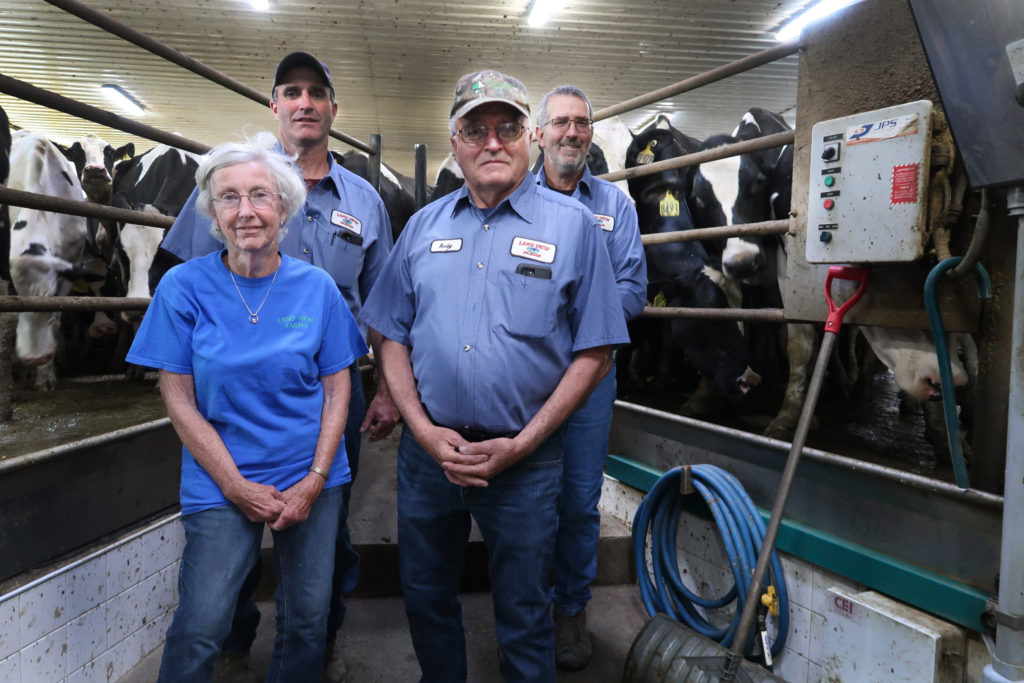
A family dairy farm for more than 50 years. Landview Farms was established in 1966 by the Walker family in White Creek, NY. It is currently operated by the second and third generation of Walkers. Roland (or Rody as friends call him) provides overall guidance and direction. His wife Jane, manages the finances. Their son, Randy, and wife, Rebecca, oversee the dairy herd. A non-family partner, Mark Anderson, manages equipment, crops and manure.
Landview considers animal care, environmental stewardship, milk quality and community connection as cornerstones of its business.
The Farm has grown from milking 170 cows to 1,400 cows today! Landview’s herd produces 11,000 gallons of wholesome milk a day, and this requires plentiful supplies of fodder. To obtain that feed, Landview works more than 2,500 acres in a 15-mile radius from the home farm in White Creek. Landview relies on high-quality forages to produce high-quality milk.
Managing The Fund’s fields. Landview Farms has been managing The Fund for North Bennington’s fields near The Mile-Around Woods since 2001. The management plan was extensively updated in 2020. Here are some of the key elements of Landview’s management of The Fund’s land in North Bennington:
Crop rotation. The new management plan rotates plantings of hay and corn – with an emphasis on hay. The plan prescribes five years of hay for each field, followed by two years of “cow corn” (corn silage). Fields are then reseeded in hay, which is cropped for five years. Crop rotation is a key management tool to conserve and build soil health. Soil micro-nutrients and trace elements can be exhausted when the same crop is sown over and over again. Pests take hold and diseases specific to that crop get harder and harder to control – while beneficial organisms and essential soil structure are lost. If rotated in a careful sequence, crops grow better, with fewer weeds and pest problems. Crop rotation maximizes soil nutrients.
“No-till” cultivation. Tilling is the digging, stirring, and overturning of plants and soil in a field. Under the new management plan, Landview will employ “no-till” cultivation to minimize disturbance of topsoil. No-till reduces risks of wind and water erosion, reduces soil compaction, and maintains soil health with less labor and use of fossil fuels. By leaving the perennial root structure in place, no-till enhances the organic content of the soil. More on no-till farming here (link to short YouTube video).
Cover crops. All harvested acres are managed with cover crops so at no time will the soil be bare and at the mercy of wind and weather. Clover, triticale and other cover crops will sustain and nourish plants, soil microbes, beneficial insects, birds and other wildlife during the months after hay or corn have been harvested.
Injected manure. Corn harvest will now be followed by an injection of manure directly into the soil. The injection method allows soil to retain more nutrients and organic matter while minimizing runoff and safeguarding water quality. Injection reduces soil compaction by using a single tractor to pull a hose — rather than relying on an oversized trailer to spread manure over all of a field’s surface. Finally, injection minimizes (but does not eliminate) odor.
Data-driven corn planting. Landview uses a 12-row planter that relies on Global Position System (GPS) data to precisely plant seeds at specific depths and locations in each field — based on the type of soil, soil health and seed variety. There is more computing power in Landview’s tractor than in the farm’s office!
Herbicide use. To plant corn in a field formerly in hay, Landview first kills the surface sod. In most situations, Landview does so by applying Roundup — a formulation of glyphosate. The use of Roundup is widespread in corn farming — but controversial. Landview is currently working with the University of Vermont to find alternative techniques or herbicides to prepare fields for corn while safeguarding soil health and water quality. Landview’s new management plan for The Fund’s fields includes limitations on use of herbicides and requires advance notice before spraying. Members of the public using trails near The Mile-Around Woods are asked to avoid walking near corn fields for 24 hours after application of herbicides. The Fund intends to post warning signs prior to herbicide application. Herbicides will only be used in connection with corn production. More information about herbicide use by Landview, including the composition of the herbicide and standards for application, can be found in the management plan linked below.
Protecting critical habitat for ground-nesting birds. With Landview’s assistance, a community project is underway to protect seriously endangered grassland birds. The Fund and two private owners have designated approximately 30 acres of fields of critical habitat for bobolinks and other ground-nesting birds for protection until the end of July each year — after which time fledglings will have left. Landview will defer its mowing of those fields until after August 1.
More information here (outside link) on building healthy soils through some of the management techniques incorporated in Landview’s management plan.